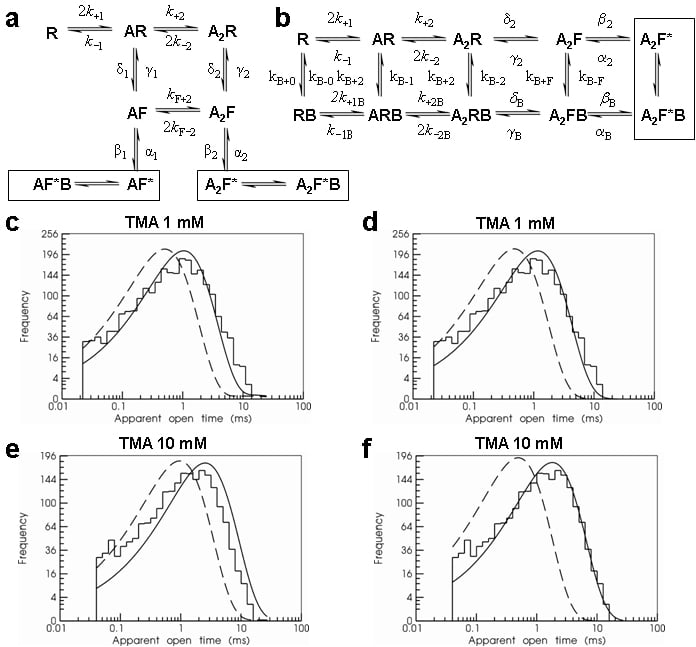Agonists at the muscle acetylcholine receptor (AChR) can all block the channel as well as activate it. For many partial agonists e.g. choline or tetramethylammonium (TMA), concentrations for activation and block are similar. We recorded cell-attached TMA-activated single-channel currents from HEK293 cells transfected with human nicotinic AChRs (αβδε, transfection ratio 2:1:1:1). In single-channel records at -80 mV, the amplitude of the openings appears to decrease progressively with agonist concentration because of fast channel block. Several records obtained at different TMA concentrations were fitted simultaneously with HJCFIT1. For TMA the equilibrium constant, KB, for open channel block was 8.9 ± 0.6 mM, as estimated from the reduction of apparent single-channel amplitude, cf EC50 of 2.2 ± 0.5 mM. If essentially no blockages are detected, the open state and the open-blocked state can be treated as a single compound open state for the purpose of analysing kinetics. Such compound states are indicated by the boxes in Fig 1a and 1b. During fitting, the exit from the compound open state in Fig 1a is given by a transition rate that is not α2 but rather α2/(1 + cB), where cB = [B]/KB and [B] is the blocker (agonist) concentration. This reflects the fact that the compound state spends only a fraction of time 1/(1 + cB) in the state from which exit can occur. Similarly, for the mechanism in Fig 1b, the transition rate for leaving the compound open state via the blocked state (A2F*B) is taken not as αB but rather αB cB/(1 + cB), i.e. αB is multiplied by the fraction of time which the compound open state spends in the blocked state. The left column shows a fit with a mechanism that allows block of channels only when they are open. The predicted distribution of apparent open times at the lower concentration (1 mM, Fig 1c) of TMA superimposes on the observations quite well, but at the higher concentration (10 mM, Fig 1e) the prediction is poor. The predominant mean apparent open time is about 1.5 times smaller than is predicted. The right column in Fig 1 shows fit of a mechanism (Fig 1b) in which the block is not selective for the open state, but can occur from any state. In this case the distribution of apparent open times is predicted accurately at both low and high concentrations of TMA. The mean values were α2 = 2370 s-1 ± 12% (CVM, n = 4 fits) and αB = 1550 s-1 ± 19%, so the channel shuts almost as fast when it is blocked as when it is not. The mean opening transition rate for the unblocked channel was β2 = 71300 s-1 ± 9%, similar to that for acetylcholine2, and for the blocked channel, the mean opening rate was almost as fast, βB = 49000 s-1 ± 9%. Thus TMA seems not act as a pure open channel blocker, but AChRs blocked by TMA can close and return to their resting state without re-opening.
University of Cambridge (2008) Proc Physiol Soc 11, PC84
Poster Communications: Channel blocking properties of a partial agonist at the human muscle acetylcholine receptor
R. Lape1, D. Colquhoun1, L. G. Sivilotti1
1. Pharmacology, UCL, London, United Kingdom.
View other abstracts by:
Where applicable, experiments conform with Society ethical requirements.

